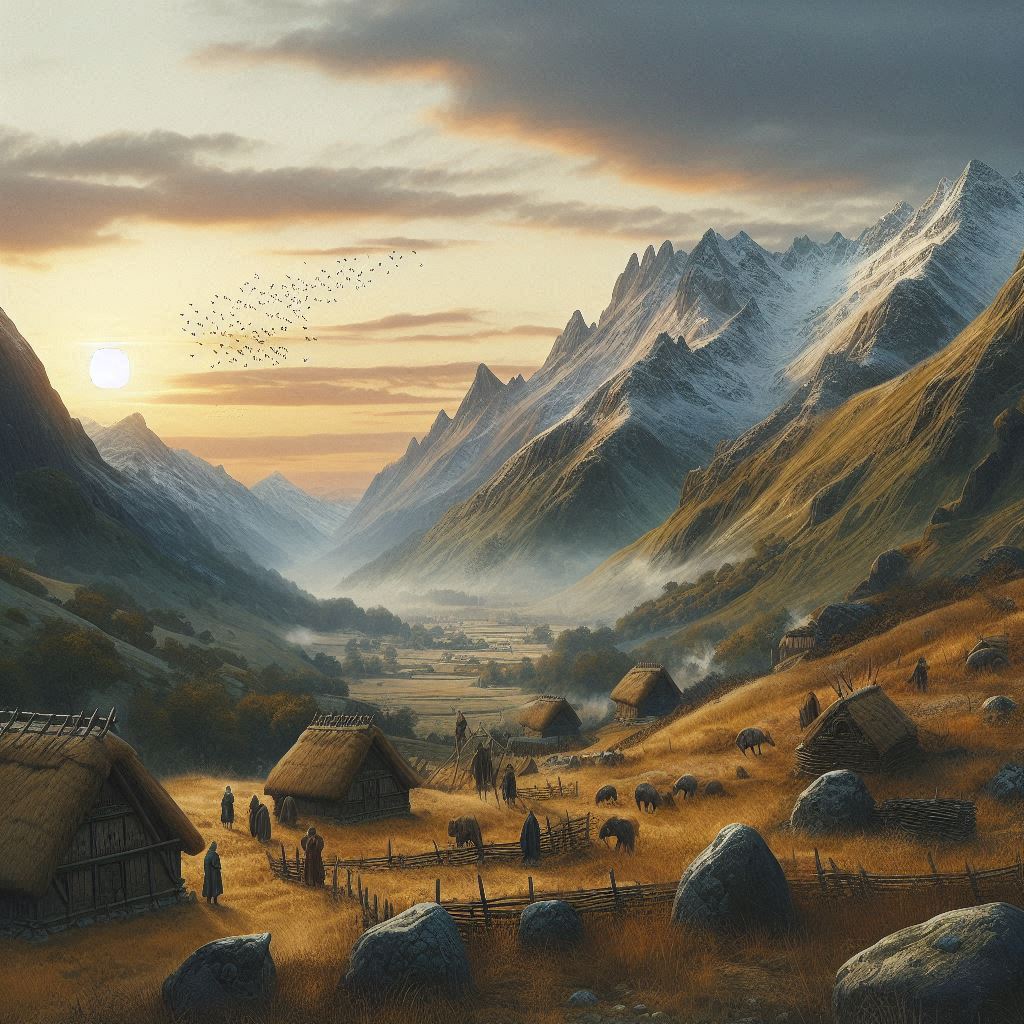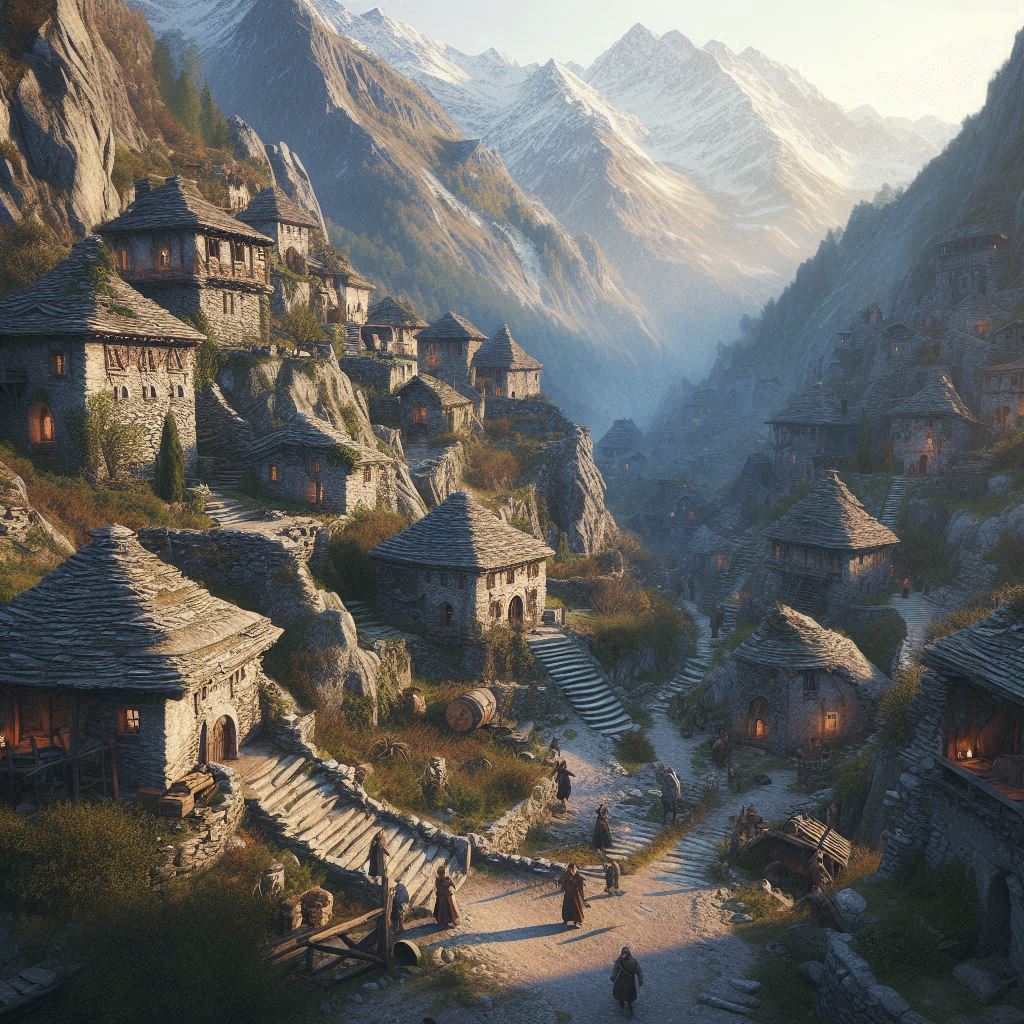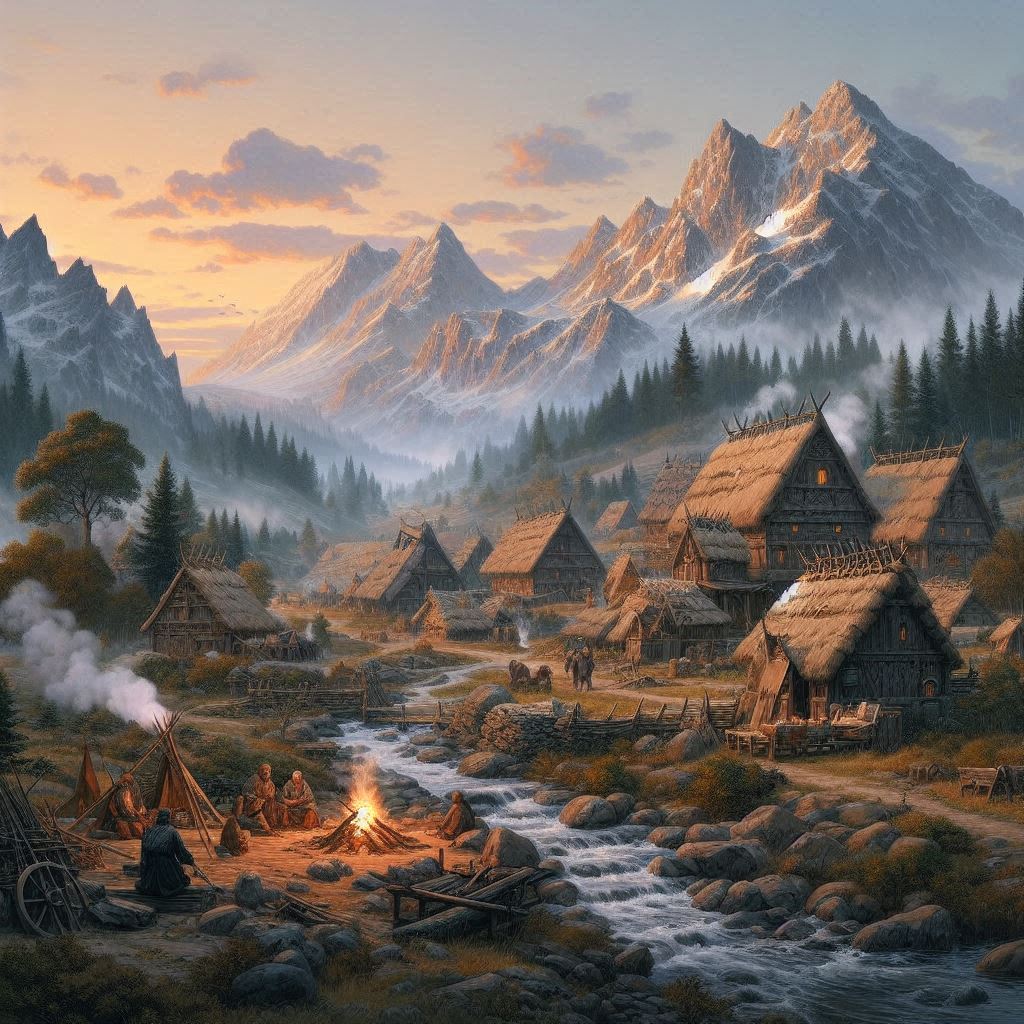Mountain culture
CULTURES SKILLS
- Ambush
- Direction Sense
- Foraging
- Grappling Hook
- Hunting
- Loading
- Rappelling
- Read Tracks
- Rope Mastery
- Set Traps
- Stone Evaluation
- Stone-Crafts
- Stone-Working
- Trap Building
- Climbing
- Hide Item
- Jumping
- Mining
- Tracking
- Weather-Watching
- Caving
Legend
“Hacking deep and moulding stone, these folk shape mountain bone—and bring forth exquisite gems, metals, and minerals.”
Description

Mountaineers are hardy, resilient people, accustomed to harsh climates and treacherous terrain. They value strength, endurance, and self-sufficiency, living lives deeply intertwined with the natural rhythms of their mountainous environment. Their days are filled with herding, hunting, gathering, and mining, forming a tight-knit community that relies on each other for survival.
Lifestyle: The extreme weather conditions, limited resources, and geographical isolation shape their lives. Strong familial and tribal bonds are essential for survival. Depending on the altitude and climate, they might raise livestock or hunt for sustenance. They hold a deep reverence for mountains, spirits, or deities, often believing in spiritual intermediaries who communicate with the spirit world.
Diet: Mountain diets rely on hardy crops like barley and potatoes, along with meat and dairy from goats and sheep. They also hunt mountain game and gather wild herbs and berries. Their diet is designed to provide energy and warmth in a cold, high-altitude environment, focussing on filling and nutrient-dense foods.
Traditions and Stories: Mountaineers pass down history, legends, and wisdom through spoken word. They revere deceased family members as protectors or guides and celebrate the cycles of the seasons and natural phenomena. Their belief in spiritual intermediaries plays a significant role in their cultural practices.
Marriage Pattern: Marriages are often arranged to strengthen alliances between families or clans. The gender ratio and societal needs can influence marriage patterns, but individuals are typically required to contribute to the community before marrying.
Religion: Variations of subdued rituals with some organised cults and shrines exist. Most revere local or community spirits, although principal worship focusses on the “true gods.”
- Religious system: Polytheism in a pantheon of gods representing various aspects of mountain life.
- God-Mortal Interaction: Powerful deities associated with mountains, storms, and avalanches are praised.
- Rituals: sacrifices to mountain gods for protection, coming-of-age ceremonies, and festivals celebrating survival and ancestors who conquered the harsh mountain environment.
- Impact on Society: A strong sense of community and interdependence. Respect for elders and traditions is paramount.
Skjald Kazumix
Craftsmanship: They create tools, weapons, and household items from local materials. Using mountain rocks, they shape tools, sculptures, and building materials. Clothing, blankets, and ropes are made from animal hair, flax, or other available fibers. If they have access to ore, they forge basic tools and weapons.
Clothing & Decoration: Clothing is made from animal hides, wool, or thick fabrics to withstand cold weather. They use plants and minerals to colour clothing and textiles, and their simple jewellery, made from bone, stone, or metal, often has symbolic meanings. These items serve as forms of personal expression or status markers.
Armor: Armour provides protection against the elements and minor threats. Warriors or leaders may add metal plates to increase protection. The armour is designed for mobility in mountainous terrain.
Weapons: Weapons are versatile for hunting and combat, suitable for close-quarters fighting and using natural materials for ranged weapons. Common weapons include axes, spears, and bows.
Special Items: Special items include knowledge of local plants for healing and medicinal purposes, passed down through generations and believed to possess magical or spiritual power. They also use materials such as bear fur, eagle feathers, or wolf pelts for special occasions or ceremonial purposes.
Skjald Sigurd
Time: Mountaineers follow a schedule, which is governed by changes in weather patterns, mining, and herding cycles. They might mark snowmelt, avalanches, and celestial events.
Accomplishment and achievement: Community achievements in mining, crafting, and defence are significant. Personal endurance, scaling peaks, mastery of difficult surroundings, survival, overcoming challenges, gathering precious minerals, and guarding mountain passages are all essential.
Authority Interaction: Respect for elders and those who have successfully reached great peaks. Stoic leaders are lords or wise sages known for their perseverance, knowledge, and strength.
Fears & Inabilities: They hold local superstitions and fears, particularly related to mountain spirits and omens.
Mien: Culture has a medium influence on demeanour, but individual personality is still evident.
Mannerism: Practical, aggressive, hard-working, and inquisitive, potentially solitary, contemplative demeanour.
Prejudices: They are generally uncomfortable with Nomads, Mariners, and Nobility but can deal with most outsiders due to their worldly experience.
Skjald El Mary
Resistance: Mountaineers might have developed resistance to diseases that spread in densely populated areas. Their exposure to different cultures and environments could have contributed to some immunity.
Disease Resistance: Moderate. Living in close-knit communities in harsh environments has given them some resistance to common illnesses.
Poison Resistance: Moderate. Their knowledge of local plants and minerals includes an understanding of both poisons and antioxidants.
Remedies: They have access to sophisticated medical knowledge, including herbal remedies, concoctions, and alchemical treatments.
Skjald Valgrif
History

Mountaineer cultures often have a history of isolation, leading to the development of unique traditions and languages. They have tales of legendary mountain spirits or guardians, and their histories are marked by endurance and survival against the odds.
Skjald Sejrik
Cartography

Mountaineers thrive in the unforgiving conditions of mountains, developing detailed knowledge of the terrain, including hidden paths, safe havens, and resource-rich areas.
Skjald El Mary
Organisation

Mountaineer societies are typically small and close-knit, with leadership based on wisdom, strength, or spiritual authority. They have a strong sense of communal ownership of the mountain and its resources, with decisions often made through consensus or council.
Skjald Yell'a'Beard
Special

Mountaineers possess exceptional climbing and survival skills. They have a deep knowledge of mountain plants and animals, as well as a strong connection to the spirits of the mountains. Their craftsmanship in stone and metalwork is unparalleled, producing exquisite gems, metals, and minerals.
Skjald Kazumix
Last Updated on 2024-10-20 by IoM-Christian
